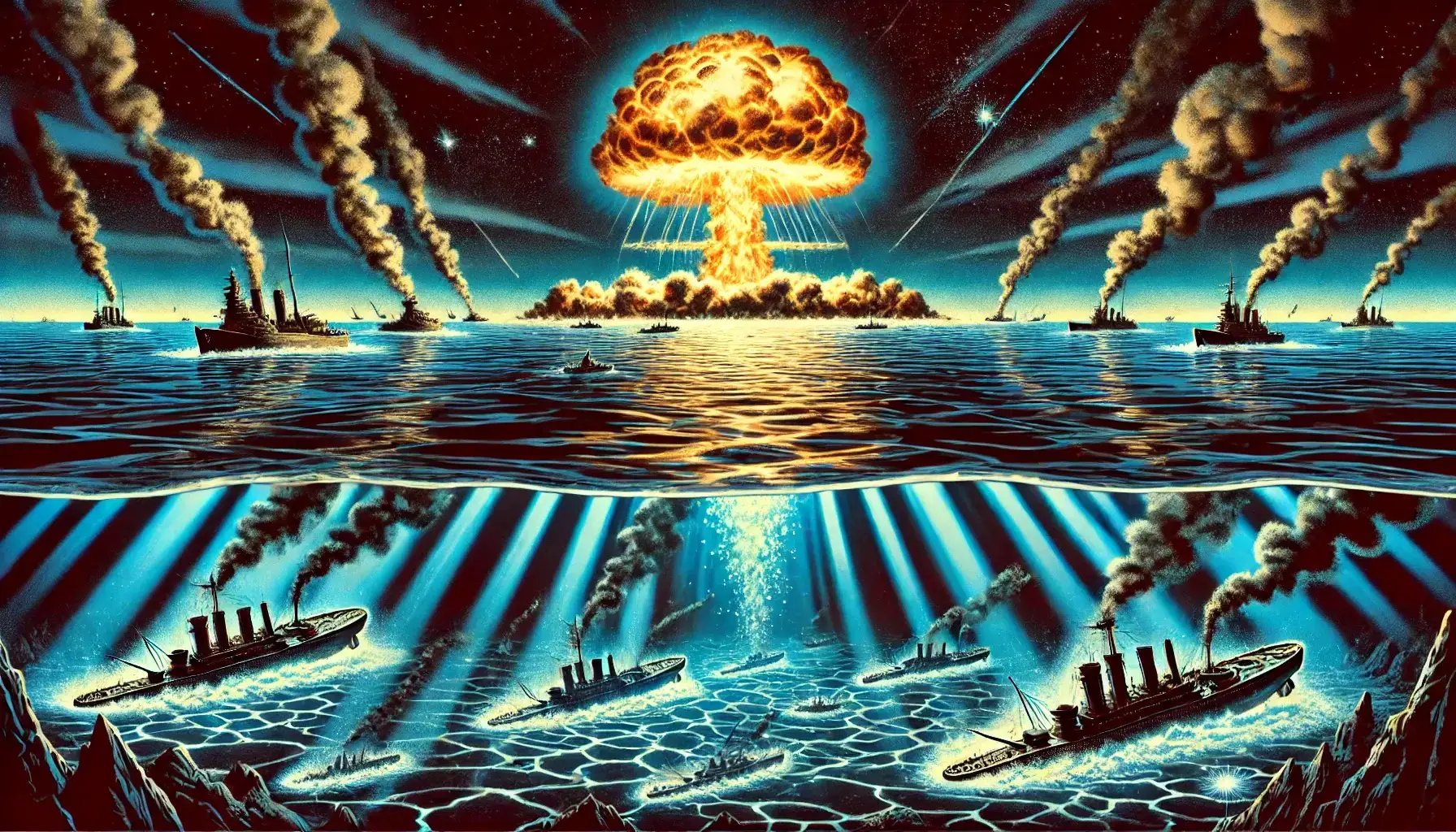The Loudest Secret in the World

The Possibility of Hidden Global Nuclear War
The loudest secret in the world has been kept for far too long. The world has long operated under a dangerous illusion: that nuclear warfare ended with the bombings of Hiroshima and Nagasaki. Officially, nuclear weapons have not been used in combat since 1945. Yet, the statistical improbability that only two nuclear weapons have ever been deployed in warfare, alongside mounting environmental and geopolitical anomalies, forces me to ask a critical question: What if nuclear warfare has continued in ways that remain hidden from public view?
My theory is that nations, including the United States, have not only continued nuclear operations but have evolved them into a new theater—beneath the oceans. This covert activity is the “loudest” secret in the world: a secret so large, so consequential, that its effects ripple through our environment, geopolitics, and even scientific discourse. And yet, nobody is willing to talk about it.
The Origins of “Climate Change” and “Global Warming”
The phrases “climate change” and “global warming” emerged after World War II, coinciding with a new era of environmental awareness. But while these terms have become staples in discussions about fossil fuels and industrial emissions, they’ve also been wielded as convenient explanations for phenomena we don’t fully understand.
In the 1950s and 1960s, as nuclear testing ramped up, atmospheric and oceanic disruptions were already being detected. Instead of attributing these disruptions to military activity, public discourse shifted toward the impact of industrial pollution and fossil fuel emissions. This framing dominated scientific conversations for decades, while studies on the environmental effects of consistent nuclear explosions—especially underwater—were conspicuously absent.
Today, the wildfires in California, historic hurricanes in Florida, and other “natural disasters” are often blamed on climate change. But where is the evidence linking these events directly to fossil fuel drilling or industrial emissions? The lack of specificity in these claims leaves a gap in understanding that is too often ignored. No comprehensive study has ever examined how decades of underwater or atmospheric nuclear explosions have affected weather patterns, ocean currents, or seismic activity. This omission feels deliberate, as if the world has collectively decided to look the other way.
The “loudest” secret isn’t just that nuclear warfare has evolved—it’s that the noise surrounding climate change has drowned out any discussion of its true causes.
The Legacy of U.S. Nuclear Policy and Adversarial Conflicts
American Presidents and Threats of Nuclear Destruction
The United States’ relationship with nuclear weapons has always been paradoxical. While it advocates for non-proliferation, it has routinely used nuclear threats to assert dominance. This is especially evident in its approach to North Korea:
- Harry Truman (1950): During the Korean War, Truman openly threatened nuclear force, declaring, “We will take whatever steps are necessary to meet the military situation, just as we always have… This includes every weapon that we have.”
- Dwight Eisenhower (1953): Eisenhower employed nuclear brinkmanship to pressure North Korea and China into signing the Korean Armistice Agreement.
- Bill Clinton (1994): Clinton considered preemptive strikes on North Korea’s nuclear facilities, stating that nuclear use by North Korea “would be the end of their country as they know it.”
- Donald Trump (2017): Trump threatened North Korea with “fire and fury like the world has never seen” and referred to Kim Jong-un as “Rocket Man.” His rhetoric escalated tensions before pivoting to historic summits.
- Joe Biden (2023): Biden echoed his predecessors, warning that a North Korean nuclear attack “will result in the end of whatever regime were to take such an action.”
These threats, often couched in deterrence language, reflect the United States’ willingness to use nuclear force if provoked. They’ve also fostered a global environment where adversaries, particularly North Korea and Russia, feel justified in developing covert and advanced nuclear capabilities.
Russia and North Korea: Subtle but Strategic Actions
While the U.S. has historically been open about its willingness to use nuclear force, adversaries like Russia and North Korea have employed more subtle, yet equally dangerous, tactics.
Russia’s Arctic Drills and Sabotage of Undersea Cables
In October 2024, Vladimir Putin conducted extensive nuclear drills simulating land-based strikes. These exercises, part of Russia’s military doctrine, are intended to showcase readiness and intimidate adversaries. However, they also raise questions about whether similar drills—potentially involving underwater operations—are being conducted in unmonitored regions like the Arctic or Pacific. Russia has also been linked to the sabotage of undersea cables. Recent incidents in the Baltic Sea demonstrate how energy and internet cables are being severed or disrupted, likely as part of a strategy to destabilize infrastructure and control information access globally.
The possibility that Russia could employ underwater nuclear boobytraps as an intimidation or deterrence tactic cannot be ignored. By laying these traps near critical underwater infrastructure, they could silently threaten global commerce and communications while maintaining plausible deniability.
North Korea’s Pacific “Firing Range”
In 2023, North Korea threatened to turn the Pacific Ocean into a “firing range” for its missile tests, a statement that may have been dismissed as bluster. But what if their strategy is more sophisticated? By not visibly showing where these explosions occur, North Korea could be conducting underwater tests designed to avoid detection. Their Haeil UUV program explicitly aims to disrupt naval fleets and coastal regions, reinforcing the likelihood that these threats are more than rhetorical.
The NJ Drone Affair: A Signal of Government Losing Control
In late 2024, Congressman Jeff Van Drew suggested that Iran was behind mysterious drone sightings over New Jersey. He speculated that a “mothership” was operating these drones, even though it was stationed across the world at the time. This incident fueled conspiracy theories that the drones were “sniffing out” a loose nuclear weapon, though no evidence supports this claim.
Regardless of the truth, the chaos surrounding the incident reveals an important point: the government appears to be losing control over its ability to keep this secret. Public speculation, fueled by conflicting narratives and unexplained events, shows that the “loudest” secret in the world may not remain hidden much longer.
The Evolution of Nuclear Warfare: From Air to Sea
Nuclear warfare has always been shaped by technological advancements. In the 1940s, nuclear weapons were dropped from planes. By the 1960s, submarines armed with ballistic missiles added stealth to nuclear strategy. Today, underwater nuclear detonations represent a particularly insidious form of warfare.
The density of water amplifies their effects, creating shockwaves that travel farther and faster than in air. These explosions also generate gas bubble oscillations, rogue waves, and potentially even artificial tsunamis. Unlike conventional warfare, underwater detonations leave few visible traces, making them ideal for covert operations.
Scientific Context: Meteotsunamis and Oceanic Disruptions
The ocean is an incredibly complex system, influenced by both natural and anthropogenic forces. Understanding phenomena like meteotsunamis is key to discerning what might be natural versus man-made:
- Meteotsunamis: These are large waves caused by sudden atmospheric pressure changes, such as storms or air mass collisions. Unlike seismic tsunamis, which are triggered by earthquakes, meteotsunamis can occur without any tectonic activity. If atmospheric pressure shifts are artificially induced—say, by an underwater explosion—they could mimic natural meteotsunami conditions.
- Rogue Waves: Naturally occurring rogue waves are massive and unpredictable. Engineered rogue waves, or “Wave Assaults,” could be created through underwater detonations, targeting naval fleets or offshore infrastructure.
- Sediment Disruption and Glowing Anomalies: Underwater explosions disturb sediment layers, releasing materials that could explain glowing anomalies seen in satellite imagery over regions like the Bahamas, the Persian Gulf, and China’s maritime zones.
I believe these anomalies are not random but rather evidence of deliberate activity—possibly underwater detonations disguised as natural oceanic behavior.
The Need for Truth Is Resounding
The old philosophy that the truth panics the public no longer holds. People are already panicked and confused. Admitting the truth about underwater nuclear warfare will be a “truth shock,” but it’s a necessary one.
I believe I’m right about this. Without access to classified information, I’ve pieced together evidence that points to a hidden nuclear conflict. The only way to break through the noise is to ask the right questions—and to demand answers.
